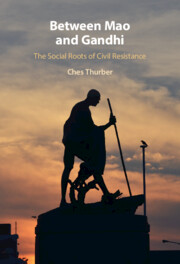Book contents
- Frontmatter
- Dedication
- Contents
- List of Figures
- List of Tables
- Acknowledgments
- 1 Pathways to Revolution
- 2 Social Ties and Civil Resistance
- 3 Nepal’s Gandhians Take Arms
- 4 Nepal’s Maoists Take to the Streets
- 5 Syria in the Arab Spring
- 6 Resisting Colonial Rule in the Syrian Mandate
- 7 Barriers to Civil Resistance: A Global Analysis
- 8 Gandhi Revisited: Overcoming Barriers to Civil Resistance in South Africa and India
- 9 Conclusion
- Appendix: Notes on Field Research in Nepal
- References
- Index
- Series page
9 - Conclusion
Published online by Cambridge University Press: 17 September 2021
- Frontmatter
- Dedication
- Contents
- List of Figures
- List of Tables
- Acknowledgments
- 1 Pathways to Revolution
- 2 Social Ties and Civil Resistance
- 3 Nepal’s Gandhians Take Arms
- 4 Nepal’s Maoists Take to the Streets
- 5 Syria in the Arab Spring
- 6 Resisting Colonial Rule in the Syrian Mandate
- 7 Barriers to Civil Resistance: A Global Analysis
- 8 Gandhi Revisited: Overcoming Barriers to Civil Resistance in South Africa and India
- 9 Conclusion
- Appendix: Notes on Field Research in Nepal
- References
- Index
- Series page
Summary
Civil resistance has proven itself to be a powerful force in international politics over recent decades. What this book has shown, however, is that the story of how civil resistance works begins long before protesters take to the streets demanding regime change. Challengers have been working for years to build organizations, form coalitions, and experiment with various tactics of resistance. The state has been playing this game as well, trying to pre-empt, co-opt, repress, and shatter organized challenges to its rule. The result is that not all challengers are equally positioned to attempt civil resistance. While traditional theories of contentious politics put great emphasis on the ability of states to shape and constrain the political opportunities available to challengers, the central argument of this book has been that the specific attributes of challengers matter as well. Challengers with social ties that link their core members to multiple social groups as well as to key pillars of regime support will be well positioned to engage in civil resistance while those lacking such ties will not. This concluding chapter provides a final reflection on the argument and evidence as well as implications for research, policy, and activism.
- Type
- Chapter
- Information
- Between Mao and GandhiThe Social Roots of Civil Resistance, pp. 218 - 235Publisher: Cambridge University PressPrint publication year: 2021



